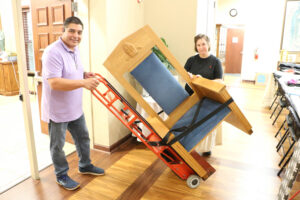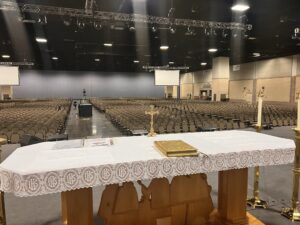Many people, a lot of hours go into planning an ordination Mass
By Emily Booker
It takes a diocese to elevate a bishop.
When guests stepped into the Knoxville Convention Center on July 26 for the ordination and installation of Mark Beckman as the fourth bishop of the Diocese of Knoxville, they were eager to begin a new chapter in the history of the Catholic Church in East Tennessee.
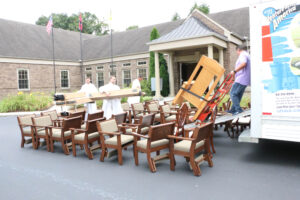
Deacon Fredy Vargas is assisted by Father Elijah Cirigliano, Brother Joseph Harp, and Brother Martin Ellis of the Benedictines of Divine Will in transporting chairs. (Photo Bill Brewer)
But it took weeks of preparation and thousands of man-hours to take care of every detail to reach this monumental day.
The undertaking of such a large event involved many people, most working on short notice to finalize and execute plans in time ever since Bishop Beckman was appointed the next shepherd of the Diocese of Knoxville on May 7.
“Looking back upon these past three months, from the day when we first learned at the beginning of May that the Holy Father had selected then-Father Mark Beckman to be the fourth bishop of Knoxville until his ordination/installation on July 26, it was absolutely incredible how much work was accomplished in such a relatively short amount of time,” said Deacon Sean Smith, chancellor of the Diocese of Knoxville and chairman of the ordination/installation planning team.

Daniel Newgent, left, of M&M Productions, goes over technical details at the Knoxville Convention Center with, from left, Deacon Walt Otey, Deacon Sean Smith, Glenn Kahler, Sharon Brown of the convention center, Paul Simoneau, and Daniel Beckner of M&M Productions. (Photo Jim Wogan)
It was a busy but exciting time as the East Tennessee faithful prepared to welcome their new spiritual leader.
Deacon Smith worked closely with the bishop-elect from the very start to go over the numerous details in planning the ordination and installation while ensuring that as many people as possible could join in the celebration.
Planning included logistics, invitations to bishops and dignitaries, the liturgy and music, communications, hospitality, transportation, hotels, and security.
The Knoxville Convention Center was chosen as the location for the ordination and installation Mass, as its capacity allowed the greatest number of the faithful from East Tennessee, the Diocese of Nashville, and beyond to attend the historic event in person.
The convention center also served as the site for past ordinations. The elevated platform serving as the sanctuary was 60 feet by 40 feet, providing enough space for such a large liturgy.
From exhibition hall to sacred space
But how does one turn such a large, open venue into a sacred space worthy of the Mass?
“Those that have a background in sacred architecture, designing churches, cathedrals, always say that you begin with the altar first and work your way out from the altar since that is the center of the holy sacrifice of the Mass,” said Paul Simoneau, vice chancellor of the Diocese of Knoxville, vice chair of the ordination team, and chair of the ordination logistics committee.
The altar for the ordination came from Holy Cross Church in Pigeon Forge. It was hand-carved by Deacon Otto Preske in the early 1990s and has been used in past diocesan events such as the 2013 Eucharistic Congress in Sevierville and the 2009 ordination of Bishop Richard F. Stika.
“It’s a very large altar. It’s a very beautiful altar. It has a carving beneath of the Last Supper. It’s very appropriate for this particular venue because of its size,” Mr. Simoneau said.
Holy Cross was not the only parish that contributed to the temporary sanctuary. The crucifix hanging above the altar came from St. Thomas the Apostle Church in Lenoir City. Holy Ghost Church in Knoxville supplied the ambo.
The tabernacle was handcrafted by Pedro Garcia, who works at St. John Neumann Church in Farragut. He originally designed the tabernacle for a retired priest to use in his residence.
The cathedra is the official seat of the bishop. It is from the word cathedra that a cathedral gets its name.
Because the current cathedra in the Cathedral of the Most Sacred Heart of Jesus is made of marble and is not able to be transported, the presiding chair came from the Religious Sisters of Mercy of Alma convent in Knoxville. The chair was the wooden cathedra from the former Sacred Heart Cathedral and now serves as the presiding chair when the bishop celebrates Mass for the Sisters.
Jerry Dougherty oversaw the careful transport of the large sanctuary items as they were packed and moved to the convention center just two days before the Mass with the help of Mitchell Moving Co.
Holy Cross Church, Holy Ghost Church, and the Chancery donated chairs for the bishops and priests.
Many hands make light work
From receptions to security to seating plans, dozens of lay volunteers gave their time to prepare for the day and to help during the ordination.
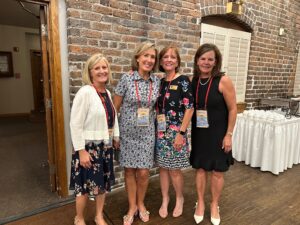
Beckman family dinner team, from left, Tami Hartmann, Carol Taylor, Dianne Kelly, and Carol Connor. (Photo courtesy Lisa Morris)
“To assist us in this monumental endeavor, we were blessed with the most talented cadre of volunteers and Knights of Columbus whose tireless work and many sacrifices made Bishop Beckman’s ordination and installation such a resounding success,” Deacon Smith said.
Deacon Smith particularly noted Mr. Simoneau’s role and efforts in the planning.
“I am most especially grateful for the herculean help and the scrupulous logistics talent and planning of my ‘right-hand-man’ Paul Simoneau … who did not take a single day off between the end of April until the week following the event, working 16-18 hour days in the final weeks leading up to July 26, with an average of four to four and half hours of sleep a night,” Deacon Smith said.
“I am also so very grateful to Paul’s wife, Ann Simoneau, whose yearlong cancer treatment ended in a most unexpected way the week before the ordination with a six-day hospitalization and two surgeries. Knowing Paul’s critical responsibilities, she told him to focus on all the final planning and to not worry about being with her as she saw it as a blessed occasion, as part of God’s providential will, for which to ‘offer up’ her surgeries for the blessing of this special occasion and for our new bishop,” he added.
Janie Hennessy, executive assistant to the chancellor and chair of the invitation committee, quickly developed invitations, mailed and recorded RSVPs, and maintained lists of the bishops, priests, deacons, religious, dignitaries, family members, and other special guests attending.
Lisa Morris of the Cathedral of the Most Sacred Heart of Jesus served as chair of the hospitality committee. Her team made sure that out-of-town and special guests were greeted and provided transportation the entire weekend. They also warmly welcomed all the guests who attended the ordination Mass and helped with the admissions process.

The Knoxville Diocesan Council of Catholic Women who placed programs on 4,000-plus Mass seats. (Photo courtesy Lisa Morris)
“The admissions process is very, very key to ensuring everybody’s first impression of this ordination and installation is a positive one,” Mr. Simoneau said. “The hospitality committee headed by Lisa Morris made huge amounts of effort to make that first impression the most positive experience possible so that it carried through to the rest of this memorable day.”
Members of the Knoxville Diocesan Council of Catholic Women helped prepare the thousands of seats with programs for guests.
Knights of Columbus from both the Diocese of Knoxville and the Diocese of Nashville helped in several capacities, including manning the parking garages and giving directions, escorting bishops and dignitaries, and manning the aisles of the convention center during the Mass.
“They’re always indispensable,” Mr. Simoneau said of the Knights.
Butch Bryant, who is retired from the Knox County Sheriff’s Office, headed security for the occasion. Mr. Bryant also headed security for the cathedral dedication in 2018. He coordinated with the Sheriff’s Office, the Office of Homeland Security, and other security professionals to make sure the venue was secure and safe for all attending.
Coordination with institutions and companies was another side of the logistics challenges to the day.
Mr. Simoneau was able to work with the University of Tennessee to rent out two of the university’s parking garages for the day, providing free parking and shuttle service for the thousands who descended on downtown Knoxville for the Mass.
Shuttles also helped the visiting bishops and Bishop Beckman’s family attend the Vespers service the night before at the cathedral.
“Special thanks go to Mike Wills, Walt Hanson, Jerry Dougherty, and Rich Cataldi. They manned the parking lot and garages that the diocese leased for the day and coordinated the golf-cart shuttles, borrowed through the generosity of No Limit Carts out of Kodak to assist with the ferrying of bishops and priests,” Deacon Smith said.
Mr. Simoneau also worked with several downtown hotels to offer discount rates for out-of-town guests.
He wanted to make it as easy as possible for guests, especially those coming from outside of Knoxville, to navigate the city and its Friday-afternoon traffic.

Ordination livestream team Jim Wogan and Father Randy Stice. (Photo courtesy of Daniel Newgent / M&M Productions)
Jim Wogan, communications director for the Diocese of Knoxville and ordination communications committee chair, worked with M&M Productions of Oak Ridge to provide the needed and appropriate audiovisual elements at the convention center.
Mr. Simoneau noted that the lighting added to the effect of turning the convention center into a worshipful space for the celebration of Mass.
“With the lighting, I think people were very stunned by how beautiful it looked,” he said.
Spanish speakers attending the Mass were provided translation devices, with live translation of the events. Blanca Primm, director of the diocesan Office of Hispanic Ministry, contributed the translation with Coral Getino and Lilia Walker.
The communications committee also was able to provide livestreaming of the ordination Mass so that people throughout East Tennessee and all over the world could watch and share in the historic event, only the fourth one in diocesan history.
Father Randy Stice, director of liturgy and worship for the Diocese of Knoxville, served as commentator for the livestream viewers, providing description and context to the rite.
With all this preparation, the stage was set, literally, for the grand celebration of ordaining a new bishop and installing him as the fourth shepherd of the diocese.
‘Making melody to the Lord’
Some 140 musicians volunteered their time and talents to elevate the ordination Mass with moving and pastoral sound.
“Afterwards, Bishop Beckman would comment to us that there were two things he repeatedly heard from family, friends, visiting bishops, and the many faithful—the incredible hospitality and the music,” Deacon Smith said.
Glenn Kahler, director of music and liturgy for the Cathedral of the Most Sacred Heart of Jesus, coordinated the music liturgy. He put together the diocesan adult and youth choirs, who, along with the Tennessee Wind Symphony, created a heavenly, harmonious tone for the ordination Mass.
This wasn’t Mr. Kahler’s first time putting together a diocesan choir for a large celebration. He did similarly for the dedication of the new cathedral in 2018, and that experience greatly helped when he began planning for the bishop’s ordination and installation.
“I was able to talk to music directors of every parish in the Diocese of Knoxville and start the process of developing a relationship, and with the individual music ministries that they have,” he said.
“We’ve managed to continue those relationships. So, when we had an opportunity again to bring everybody together, we already had a network of people to contact and reach out to.”
Those relationships proved especially important as the timeline between Bishop Beckman’s appointment in May and ordination in July gave musicians only a matter of weeks to put together ensembles and rehearse music.
Mr. Kahler noted how summertime is often when church music directors and musicians have a pause in the calendar, so finding available talent and asking them to forgo their summer breaks was a big ask. He cancelled his own family vacation to focus on preparing the music for the Mass, as well as developing the beautiful and detailed printed program.
Many other musicians also responded to the call in order to lend their talents for such an important moment in the history of the Catholic Church in East Tennessee.
Cathedral music coordinators Michelle Pokelwaldt and Ashton Gallagher assisted in organizing the music and putting together the choir.
Just over a hundred singers formed the diocesan choir, including youth and adults. They came from all over the diocese, and even beyond.
“We have people coming in from Nashville, Chattanooga, Tri-Cities, and they’ve been coming in ever since the auditions on a weekly basis,” Mr. Kahler said.
The choir was truly a demonstration of collaboration and even ecumenical outreach.
“It’s not just Catholic churches,” Mr. Kahler said. “Singers of other denominations wanted to be a part of this really significant event.”
The singers represented almost every parish music ministry in the diocese, along with professional ensembles and other denominational churches.
Byong-Suk Moon, assistant director of music and organist for the Cathedral of the Most Sacred Heart of Jesus, was the organist for the Mass.
A large ensemble of the Tennessee Wind Symphony, directed by Dr. John Culvahouse, provided the rest of the instrumental music.
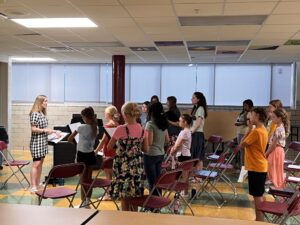
Students in the ordination Mass youth choir practice at Sacred Heart Cathedral School, led by Ashton Gallagher at left. (Photo Emily Booker)
“They became artists in residence here at the cathedral back in 2020. We’ve hosted them on our campus, and they’ve reciprocated by always being there for us for these types of events,” Mr. Kahler said.
It takes much practice and dedication to put together a choir in just a few weeks. The musicians met for weekly rehearsals at the cathedral, some driving hours each way.
“I think we owe a debt of gratitude to every single person who’s spent time and sacrificed their own personal hours, their families’ hours, during a time that is supposed to be for travel and fun and leisure,” Mr. Kahler said. “They sacrificed a lot to prepare for this liturgy.”
He estimated that the 140 musicians of the choir and orchestra put in between 6,000 and 7,000 man-hours over the summer to provide quality music for the bishop’s ordination Mass.
On the morning of July 26, the musicians were finally able to rehearse in the convention center for the first time. With just hours to set up their instruments and adjust to the acoustics of a new space, they still managed to produce glorious music and a prayerful sound.
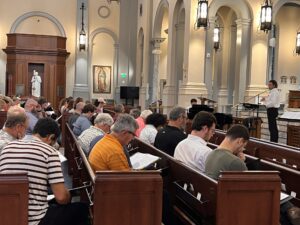
Glenn Kahler, standing, leads ordination Mass vocalists in practice at the Cathedral of the Most Sacred Heart of Jesus. (Photo Emily Booker)
In various ensembles, the musicians provided an hour of prelude music before the Mass began, welcoming attendees and setting the tone for the Mass.
Mr. Kahler said he had been working on the music and tone for the ordination Mass even before Bishop Beckman’s appointment was announced.
“Ever since we found out that we were going to be getting a new bishop, that sort of started the wheels turning,” he said. “With the new version of the ordination rite coming out last year, that was helpful in giving us a starting point to begin looking through the liturgy, start looking through the prayers that are offered, and start thinking about what types of music would encapsulate that message.”
Mr. Kahler noted that selecting the music for a Mass always requires three questions: Is it liturgical? Is it musical? And is it pastoral? Music should always be in keeping with spreading the teachings of the Church and help people participate in worship during the Mass.
Once those objectives are met, then personal preferences about particular styles or pieces can be selected. Mr. Kahler worked with Bishop Beckman to makes sure the new bishop’s preferences and style showed through.
“We got to learn about who he is and his style. Every priest I’ve ever met has his own particular style or likes and dislikes, and having this opportunity to learn a new bishop’s likes and dislikes is fun,” he said.
That relationship will continue on as Bishop Beckman celebrates Mass and diocesan events at the cathedral.
Preparing the Lord’s table
Music isn’t the only part of a Mass that takes weeks to plan.
Every Mass involves careful planning and arranging all the proper elements necessary for worship. That is even more true for a Mass involving thousands of people and the ordination and installation of a bishop.
The Mass at the ordination of Bishop Beckman involved more than 5,000 hosts, four bottles of Communion wine, pounds of linens, and dozens of ciboria, the receptacles that hold the consecrated Eucharist during Communion.
An anonymous donor made it possible for the diocese to purchase 24 new ciboria and cups for the ordination. The matching pieces can be used for future large liturgies as well.
The chalice used by Bishop Beckman was gifted to him by his former parish, St. Henry in Nashville.
Dorothy Curtis, sacristan at the Cathedral of the Most Sacred Heart of Jesus and receptionist for the Chancery, coordinated the hundreds of liturgical items for the ordination Mass.
“I staged a room in my house with all this equipment. It was everywhere,” she said, laughing.
Three Benedictines of the Divine Will, Father Elijah Cirigliano, Brother Joseph Harp, and Brother Martin Ellis, helped her organize the liturgical pieces and set up for the Mass.
“We [sacristans] have to know every piece and kind of live the liturgy days before so that we’re thinking ahead: What is next? What do we need there? Where’s this going to be?” Mrs. Curtis said.
While many pieces came from the Cathedral of the Most Sacred Heart of Jesus or from diocesan supplies used at the 2013 Eucharistic Congress in Sevierville, Mrs. Curtis also coordinated pieces from various parishes and individuals who were more than willing to contribute to making the ordination Mass a success.
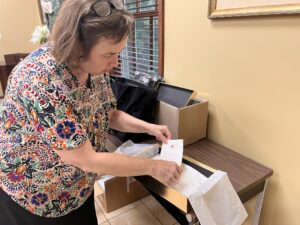
Chancery receptionist and cathedral sacristan Dorothy Curtis packs boxes of purificators for the ordination/installation Mass. (Photo Emily Booker)
The new altar cloth came from Holy Cross Church.
One of the altar cloths used on a side table, or credence table, came from the collection of Monsignor Xavier Mankel, one of the founding fathers of the Diocese of Knoxville.
“It’s very old, but it’s very nice,” Mrs. Curtis pointed out.
Yazmin Vidao, a native of Venezuela, provided and hand-stitched the purificators, the linen used to wipe the chalices and cups after each communicant. She hand-stitched a red cross on each one.
Jackie Foster sewed and provided the gremials, a special garment used during the ordination.
“A gremial is like an apron that the archbishop uses when he anoints the new bishop,” Mrs. Curtis explained.
“Jackie Foster is a seamstress, and she made the gremial for the archbishop, and she made a special gremial for Bishop Beckman for when he got the oil poured on his head. We wanted to make that kind of special,” she added.
Ms. Foster also served as the assistant sacristan of the ordination Mass.
Even regular vestments worn by priests at Mass took special planning for a liturgy of this scale.
While Diocese of Knoxville and Diocese of Nashville priests wore their diocesan vestments, the visiting bishops needed vestments as well. The Diocese of Owensboro, Ky., provided vestments for the bishops.
Deacon Fredy Vargas, facility coordinator for the Chancery, organized the vestments and helped coordinate the vesting areas for the 20 bishops and more than 100 priests.
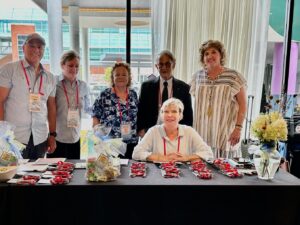
Hotel hospitality team members, from left, Tom Catani, Deanene Catani, Sally Sefton, Alan Sefton, Melissa Smith, and Polly Ailor Tullock (seated). (Photo courtesy Lisa Morris)
The altar flowers came from Always in Bloom florist. The florist, Leonard Palladino, who is a parishioner and a graduate of Knoxville Catholic High School, donated labor and transportation, and the Cathedral of the Most Sacred Heart of Jesus flower guild assisted in the arrangements. The cathedral flower guild, headed by Ann Bodie, also prepared the altar flowers for the July 25 Vespers service and the centerpieces for the honored-guests luncheon and Bishop Beckman’s family-dinner celebration.
The Cathedral of the Most Sacred Heart of Jesus also provided the bells and the Book of Gospels used in the ordination Mass.
Holy Ghost Parish provided the candles on the altar. Normally, there are six candles on the altar, but right after Bishop Beckman was ordained, a seventh candle was lit. This candle is called the episcopal candle, and it indicates the presence of the bishop of that diocese.
Similar to her efforts at priestly ordinations, one of Mrs. Curtis’ tasks was to provide a lemon. The acidic fruit helps break up the sacred chrism on the bishop’s hands after ordaining priests or conferring confirmation.
The chrism used for Bishop Beckman’s episcopal ordination is the same used for priestly ordinations.
“It’s a beautiful, sweet-smelling oil that was consecrated at the Chrism Mass during Holy Week,” Mrs. Curtis noted.
It may seem overwhelming to keep track of these objects and more, like corporals, washing bowls, cruets, tables, trays, and cups, but Mrs. Curtis said being sacristan is a joy.
“This is what I just love to do, collecting these items, making sure that they’re all there for the MC (master of ceremonies) when he goes to grab something,” she said.
“Sacristans, we’re hidden you know. And I prefer to be hidden. We are for sure behind the scenes. We work really hard, and we take what we do really seriously. If the parts aren’t there, we take it to heart.”
‘The preeminent manifestation of the Church’
With the sanctuary staged, the musicians warmed up, and the vessels set, all that was left was the celebration of Mass.
But the liturgy itself also involved much planning and preparation. The sacrament of ordaining a new bishop along with the rite of installing him as the bishop of the Diocese of Knoxville involved plenty of coordination.
“The Mass, when a bishop is ordained and when a bishop celebrates, is always sort of the preeminent manifestation of the Church, because the bishop is the successor to the Apostles. He has the fullness of orders,” Father Stice said.
“When you have a Mass with a bishop, he’s got his priests with him, he’s got ministers, he’s got deacons there. It shows, in a really profound way, the fullness of the Church. And the laity represent the people of God, so their presence is very important. It’s just a beautiful celebration.”
While the Mass is unchanging, there were certain elements of the ordination Mass in which Bishop Beckman got to select and personalize.
“There is a selection of readings for each of the sacraments that can be celebrated with a Mass,” Father Stice said. “He can pick the readings. He can pick the music. Part of the preparatory rites, he can add additional names to be included in the Litany of the Saints. Those are ways he can personalize [the Mass] a little bit.”
As the liturgical committee chair, Father Stice assisted Bishop Beckman in choosing the readings and prayers to be included for the ordination.
Bishop Beckman selected readings from Isaiah 61, which can be used for the ordination of priests or bishops and 2 Corinthians 4, which can be used for the ordination of deacons, priests, or bishops. He selected John 20:19-23 as the Gospel reading.
The Rite of Ordination has many symbolic moments, from being anointed with the chrism to receiving the symbols of his office.
(See Father Randy Stice’s article “A look at the Rite of Ordination of a Bishop”.)
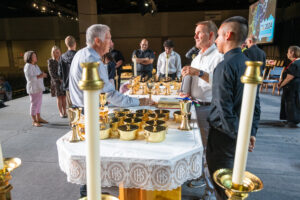
Deacon Walt Otey, left, Jerry Bodie, right center, and Deacon A.J. Houston assist in setting up the altar for the ordination and installation of Bishop Beckman at the Knoxville Convention Center. (Photo Renee McNutt / BOPP)
During the Litany of the Saints, the bishop-elect lies prostrate in front of the altar. The saintly intercessions focus on the Apostles since bishops continue the ministry of the Apostles.
Bishops may insert the names of additional saints who have special meaning to them. Bishop Beckman included St. Mark, St. Luke, St. Henry, St. Ambrose, St. Thérèse of Lisieux, St. Teresa of Kolkata, St. John XXIII, St. Paul VI, and St. John Paul II.
The bishop wanted to include St. Mark, as that is his namesake.
He also selected St. Henry after the parish in Nashville he most recently pastored before receiving his appointment as bishop.
Bishop Beckman said he chose St. Ambrose because the saint had been an inspiration for him since attending St. Ambrose College in Davenport, Iowa, where he graduated in 1984.
“St. Thérèse of Lisieux, I love her Story of a Soul, and I knew that she said when she got to heaven she wanted to pray for priests, especially troubled priests. So, when I’m troubled about something, I will turn to her,” the bishop said.
Bishop Beckman said St. Teresa of Kolkata was selected because he grew up watching her earthly witness and felt a special connection to her.
St. John XXIII, St. Paul VI, and St. John Paul II were all chosen as they were popes who helped shaped the 20th century and the Church.

Bishop-elect Mark Beckman goes over Mass details with, from left, Deacon Sean Smith, Jerry Bodie, Deacon Walt Otey, and Deacon A.J. Houston at the Knoxville Convention Center. (Photo Renee McNutt / BOPP)
Bishop Beckman also noted that he loves St. Francis of Assisi and would have chosen him if he were not already included in the standard Litany of the Saints.
Father Stice noted that the prayer of ordination goes back as far as the third century and is still used by Greek and Latin churches, further showing the continuity of the Church and the succession of the Apostles.
Following his anointing and consecration as bishop, Bishop Beckman was presented the symbols of his episcopal office: the ring, miter, and crosier.
The bishop’s ring signifies his union with the local Church and his lifetime commitment as a servant of the Lord. Bishop Beckman’s ring, designed by jeweler deBebians, is platinum with his personal coat of arms engraved on the outside and his episcopal motto, “Jesus Christ Yesterday, Today, and Forever” engraved on the inside.
The miter, or tall white hat, represents the bishop’s authority. The word miter comes from the Greek mitra, meaning crown. The diocesan miter was refitted to fit Bishop Beckman in time for the ordination.
The crosier, or pastoral staff, represents a shepherd’s crook and signifies the bishop’s role as shepherd of his diocese, entrusted with protecting and guiding Christ’s flock.
The crosier of cedar wood that Bishop Beckman will be using has great significance for the Church in Tennessee. It was the crosier of Bishop James D. Niedergeses, who served as bishop of the Diocese of Nashville from 1975-92. He was the bishop who oversaw the formation of the Diocese of Knoxville out of the eastern counties of the Nashville diocese.
Both Bishop Niedergeses and Bishop Beckman are from Lawrence County, Tenn. The Diocese of Nashville has loaned Bishop Beckman the crosier in appreciation of the close ties between the two dioceses.
(For more on the meaning of and history behind Bishop Beckman’s symbols of office, see Dan McWilliams’ article “The splendor of holiness”.)
Father Stice said that while people will see the bishop as he visits parishes in the future, witnessing him receive that duty and calling to mind the meaning of those symbols reminds everyone of the role of a bishop in caring for God’s people.
“Here they see him being given the miter and told what it means, and he’s given his crosier and told what it means, and he’s given his ring.
“I think the chance to be a part of that and to hear that can be a really profound experience, and you learn a lot about the meaning of what is a bishop and what are his responsibilities, why is he so important in the life of the Church,” Father Stice said.
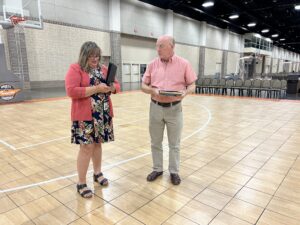
Ordination organizational leader Paul Simoneau with Knoxville Convention Center representative Sharon Brown (Photo Jim Wogan)
Through the herculean efforts of parishes, organizations, and volunteers, the Diocese of Knoxville was able to joyfully celebrate and welcome its new shepherd. Thousands from across East Tennessee and beyond witnessed this historic moment for the Church and shared in welcoming Bishop Beckman.
All the efforts came together by the grace of God to create a highly significant, memorable day in the life of the Catholic Church in East Tennessee.
“As chairman of the ordination and installation team, I am grateful to God for bringing us a such a fantastic new bishop, and I am forever grateful for being blessed with such a great cadre of volunteers throughout this whole process,” Deacon Smith said.
Mr. Simoneau reflected how, even after tirelessly working to address every detail, it is really the Holy Spirit who made such a day possible.
“They say the devil’s in the details. We like to say God’s in the details. It’s our job to try to exorcise those demons out by praying,” he said. “You know, if it doesn’t begin with prayer first and putting God first, then our planning efforts would not be what they should be. This is the ordination and installation of a successor of the Apostles, and we trust that God is going to give us what we need.”




